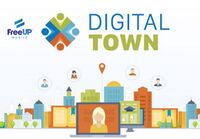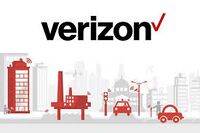Wireless
This set of 6 projects is managed by the Wireless team and is focused on development of best practices for the deployment of wireless systems. Wireless networks can be a tool for economic development, a lever for tackling the digital divide and homework gap, as a core infrastructure in IoT networks, and supporting smart city applications such as public safety, energy, lighting, transportation, and more.
The success or failure of wireless network deployments often hinges on a variety of factors and tradeoffs between public policy, physics, and economics. As a result, many municipalities have struggled to deploy and sustain these systems. The Wireless SuperCluster will address these issues by focusing annually on vertical segments within the wider wireless ecosystem, conduct analysis aimed at uncovering the best practices for successful deployments, and producing blueprints based upon that informed analysis. These analyses will be conducted in the form of interviews, workshops, and reviewed case studies. Our current roadmap for the Wireless SuperCluster is:
- 2017: Public Wi-Fi (Completed - Download The Blueprint above)
- 2019: Internet of Things (Completed - Download The Blueprint above)
- 2021: CBRS
- 2022: 5G
Chair(s)
-
[[File:|thumb|x{{{si{{{leader}}}e}}}px|link={{{leader}}}|{{{leader}}}
at
]]
Activities
| Amsterdam IoT Living Laboratory and Beacon mile | ||
We provide public networks, open infrastructure and data for developers to accelerate emerging IoT innovations for Smart City solutions
| ||

|
Bay Area Unified Wi-Fi Roaming Security and Ease of Use | |
| As more and more cities deploy public Wi-Fi service, security and ease of use are becoming critical. In addition, the service becomes fragmented and constrained by geopolitical boundaries. This action cluster will deploy and evaluate the impact of new Wi-Fi authentication and access management solutions that deliver not only the highest possible end-user security, but will allow participating municipalities to create a unified regional system that users can automatically connect to when in range, regardless of what city/county they are in. | ||

|
Campus Array Node and Array of Things Network Dual Deployment | |
| The Project entails the dual deployment of Argonne National Labs’ Array of Things (AoT, v.2) and Georgia Tech Research Institute’s Campus Array Node (CAN, v.1). In combination, these two sensor networks will aid multi-modal transit from the perspective of both operators and users.
Partnering with the City of Atlanta, Georgia Tech Research Institute, and Argonne National Labs, and focusing on issues related to multi-modal transit, the Project focuses on the on-the-ground interoperation of two Internet of Things systems—AoT focused on environmental sensing and CAN focused on traffic/public safety monitoring—and how to display real-time data for public transit operators, pedestrians, and officials in meaningful ways that inform efficient, effective, and comfortable use of various mobility options. From the engineering and infrastructural considerations to the political and community issues, the Project is a case study of a cyber-physical system that will result in a model of how to proceed with issues of interoperable Internet of Things systems, from technical standards to community engagement to areas of future work. | ||

|
City of San Leandro, CA: “SL Wi-Fiber” | |
| Since the creation of Lit San Leandro – a public-private partnership that yielded an 18mile, fiber optic loop – installing a free, Public Wi-Fi system in the city’s downtown core had been one of the City Council’s long-standing goals. | ||

|
City of Schenectady, NY: Enhanced City Services | |
| As part of Schenectady’s Lower Union Street reconstruction Project that started in late 2015, Smart Lights have recently been installed that allow the control of lighting and other sensors to monitor devices as well as provide a small scale Public Wi-Fi deployment. This deployment, activated on June 20th 2017 as Schenectady’s contribution to World Wi-Fi Day 41 , gives residents, and visitors within a 5-block area of State Street (from Broadway to Lafayette) access to the internet and is helping to identify value for further Wi-Fi deployment. 42 Wi-Fi access points also allow the city to control smart lighting and other IoT sensors that help in evaluating the benefits of various accessories. This project is in coordination with additional Wi-Fi access in front of City Hall on Jay Street that is also available for residents and visitors to the city. | ||

|
Connecting Communities with Public Wi-Fi technology and local Tourism mobile applications | |
| Provide areas of Public Wi-Fi for use by residents, employees and visitors while deploying informational mobile application showcasing local businesses and giving real time data for local trolley schedules.
Using technology to collect data which will improve the operation of local governments. | ||

|
CryptoMove San Leandro Smart Lights Project | |
| Create reference architecture for Smart Lights and Sensors via deployment of CryptoMove Moving Target Data Protection to render data onto a constantly shifting and mutating defensive fabric, thereby greatly decreasing the likelihood of exfiltration of sensitive data, and likewise for ransomware probability. | ||

|
Cybersecurity Risk Assessment and Mitigation | |
| Empower municipalities with cybersecurity risk assessment methodology and resources to enable timely understanding of their risk levels and appropriate mitigation against cyberrisks.
The risk assessment methodology is adapted from NIST Cybersecurity Framework with a Technical Risk Rating component and an Expert Assessment. The daunting resource shortage is addressed by a unique volunteer matching mechanism based on public-private partnerships. | ||

|
Deployment of user-friendly, secure and sustainable federated public Wi-Fi systems | |
| To deploy a sustainable federated public Wi-Fi solution across Singapore that is has easy to use secure authenticated access and jointly develop a set of best practices with cities, industry players, and the academia to promote coordinated public Wi-Fi deployment, to address signal interference issues, standardizing user experience and security. | ||

|
East Palo Alto Neighborhood Innovation Zone | |
Objectives
| ||

|
Environmental Sensing Across the Metro DC Region | |
| Create a network of environmental sensors placed on campuses throughout Washington DC that are participating in the DC MetroLab partnership. This effort will enable public access to environmental data like temperature, wind, gas and particulate concentration, and even traffic flows, simultaneously from all over the city. Involves city technology, planning, and networking agencies and MetroLab partners; George Washington, Georgetown, American, Howard and The District of Columbia Universities. | ||

|
Flood Judge | |
| Combining low cost / commodity sensors, enterprise IT skillsets, existing / familiar tools with the power of the cloud and artificial intelligence to proactively monitor and alert water levels in creeks during storm activity. | ||

|
IoT Device Security for Smart Cities | |
Objectives
| ||

|
LinkNYC | |
| LinkNYC is a first-of-its-kind communications network that will bring the fastest available municipal Wi-Fi to millions of New Yorkers, small businesses, and visitors. The five-borough LinkNYC network, which will be funded through advertising revenues, will be built at no cost to taxpayers and will generate more than $500 million in revenue for the City over the first 12 years. | ||

|
NerveNet: Regional Resilient IoT Platform | |
Project Description Points
| ||

|
Oregon middle-mile fiber broadband network | |
| Link Oregon, the non-profit, middle-mile broadband network serving Oregon’s
public and non-profit sectors, delivered the first two phases of its statewide network backbone in June 2021, having successfully lit nearly 2,000 route-miles of fiber-optic cable and deployed more than 50 service locations across Oregon. | ||

|
PA2040 Public Wi-Fi | |
| Create wireless mesh backhaul infrastructure as part of smart city IoT deployment throughout the 1700 to 1900 blocks of Pennsylvania Avenue, NW, Washington DC to enable public connectivity to services and enhanced connectivity for government operations and public safety. Involves city technology, planning, and transportation agencies, local Business Improvement District (BID), federal District planning agency, and technology solution providers. | ||

|
Project GRACE | |
| The present Public Key Infrastructure (PKI) is known to be inadequate for the current scale of the Internet and the situation is exacerbated with the advent of IoT. Project GRACE (Graceful Remediation with Authenticated Certificateless Encryption) implements a security architecture using an advanced form of pairing-based cryptography called Verifiable Identity-based Encryption (VIBE) to provide a simple, scalable and secure key management for the cloud services, the IoT and indeed the Critical Information Infrastructure (CII) which are otherwise vulnerable to the extant and new cyber-physical attacks. | ||

|
San Mateo County Public WiFi | |
| We live in the heart of Silicon Valley, but even in San Mateo County we have a significant digital divide between those with high speed Internet access and those with slow speed or no access. The County believes that providing high speed Internet access is the 21st century equivalent to building roads. Providing the infrastructure so that all residents have equal access to online resources is critical to supporting our shared vision of a healthy, safe, prosperous, livable, environmentally conscious, and collaborative community. | ||

|
Santa Clara County Office of Education CBRS Networks | |
| Santa Clara County Office of Education and Joint Venture Silicon Valley are cooperating with industry leaders to deploy CBRS broadband networks for addressing distance learning and homework gap challenges. | ||

|
Smart Rural Community | |
| The Smart Rural Community (SRC) network is made up of a group of carefully vetted, rural broadband providers who are committed to driving growth and creating opportunities for their communities. SRC providers enable fast, reliable and sustainable connectivity needed to thrive in an online world, especially as the demand for distance learning, telemedicine and remote work grows. And for those who live in these communities, it means equal opportunity for education, resources, entrepreneurship and more. | ||

|
SmartCU - Covenant University Smart City | |
Objectives
| ||
Webinars
| A Blueprint for Public Wi-Fi Networks | ||
| The goals of the Global City Teams Challenge program are to bring together thought leaders and experts on a wide variety of topics relating to modern “Smart City” technologies and to have them share their knowledge and create best practices to assist those who are coming after them. The authors and contributors of this blueprint have designed, built, and managed Public Wi-Fi systems all over the United States and it is this spirit of collaboration and knowledge sharing that drives this effort forward. | ||

|
DigitalTown | |
| DigitalTown is partnering with FreeUP Mobile to bring Free Wireless Service to US members of the DigitalTown movement. The deal includes a Free SIM Card and Free Wireless Service by using the FreeUP Rewards app on the nation’s largest 4G LTE network. | ||

|
Hybrid Cellular and Wi-Fi Networks | |
| What’s the value of automatic, secure Wi-Fi connectivity to a smart city? Mobile phone coverage in dense cities can suffer from blackspots and poor indoor performance. | ||

|
Smart Communities Traffic | |
| At Verizon, our goal is to help improve the quality of life for people living in cities around the world and increase the ways and efficiency in which cities operate. It’s not just about smart technology, connectivity or applications; it starts with a focus on the people and their basic wants and needs. We partner with each city to design infrastructure, systems and processes that elevate the way they provide services in new and cost-effective ways. | ||
